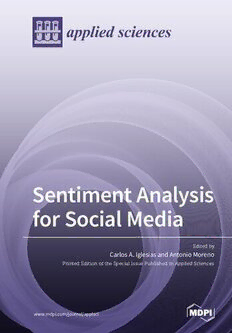
Sentiment Analysis for Social Media PDF
Preview Sentiment Analysis for Social Media
S e n t im e n t A n a ly s is f o r S o c ia l M e d ia • C a r lo s A . Ig le s ia s a n d A n t o n io M o r e n o Sentiment Analysis for Social Media Edited by Carlos A. Iglesias and Antonio Moreno Printed Edition of the Special Issue Published in Applied Sciences www.mdpi.com/journal/applsci Sentiment Analysis for Social Media Sentiment Analysis for Social Media SpecialIssueEditors CarlosA.Iglesias AntonioMoreno MDPI•Basel•Beijing•Wuhan•Barcelona•Belgrade•Manchester•Tokyo•Cluj•Tianjin SpecialIssueEditors CarlosA.Iglesias AntonioMoreno DepartamentodeIngenier´ıade Departamentd’Enginyeria SistemasTelema´ticos, Informa`ticaiMatema`tiques, ETSITelecomunicacio´n EscolaTe`cnicaSuperior Spain d’Enginyeria,UniversitatRovira iVirgili(URV) Spain EditorialOffice MDPI St.Alban-Anlage66 4052Basel,Switzerland This is a reprint of articles from the Special Issue published online in the open access journal AppliedSciences (ISSN 2076-3417) (available at: https://www.mdpi.com/journal/applsci/special issues/SentimentSocialMedia). Forcitationpurposes,citeeacharticleindependentlyasindicatedonthearticlepageonlineandas indicatedbelow: LastName,A.A.; LastName,B.B.; LastName,C.C.ArticleTitle. JournalNameYear,ArticleNumber, PageRange. ISBN978-3-03928-572-3(Pbk) ISBN978-3-03928-573-0(PDF) (cid:2)c 2020bytheauthors. ArticlesinthisbookareOpenAccessanddistributedundertheCreative Commons Attribution (CC BY) license, which allows users to download, copy and build upon publishedarticles,aslongastheauthorandpublisherareproperlycredited,whichensuresmaximum disseminationandawiderimpactofourpublications. ThebookasawholeisdistributedbyMDPIunderthetermsandconditionsoftheCreativeCommons licenseCCBY-NC-ND. Contents AbouttheSpecialIssueEditors . . . . . . . . . . . . . . . . . . . . . . . . . . . . . . . . . . . . . vii CarlosA.IglesiasandAntonioMoreno SentimentAnalysisforSocialMedia Reprintedfrom:Appl.Sci.2019,9,5037,doi:10.3390/app9235037. . . . . . . . . . . . . . . . . . . 1 HyojiHa,HyunwooHan,SeongminMun,SungyunBae,JihyeLeeandKyungwonLee An Improved Study of Multilevel Semantic Network Visualization for Analyzing Sentiment WordofMovieReviewData Reprintedfrom:Appl.Sci.2019,9,2419,doi:10.3390/app9122419. . . . . . . . . . . . . . . . . . . 5 HannahKimandYoung-SeobJeong SentimentClassificationUsingConvolutionalNeuralNetworks Reprintedfrom:Appl.Sci.2019,9,2347,doi:10.3390/app9112347. . . . . . . . . . . . . . . . . . . 31 XingliangMao,ShuaiChang,JinjingShi,FangfangLiandRonghuaShi Sentiment-AwareWordEmbeddingforEmotionClassification Reprintedfrom:Appl.Sci.2019,9,1334,doi:10.3390/app9071334. . . . . . . . . . . . . . . . . . . 45 MohammedJabreelandAntonioMoreno ADeepLearning-BasedApproachforMulti-LabelEmotionClassificationinTweets Reprintedfrom:Appl.Sci.2019,9,1123,doi:10.3390/app9061123. . . . . . . . . . . . . . . . . . . 59 ElineM.vandenBroek-AltenburgandAdamJ.Atherly UsingSocialMediatoIdentifyConsumers’SentimentstowardsAttributesofHealthInsurance duringEnrollmentSeason Reprintedfrom:Appl.Sci.2019,9,2035,doi:10.3390/app9102035. . . . . . . . . . . . . . . . . . . 75 SungheeParkandJiyoungWoo GenderClassificationUsingSentimentAnalysisandDeepLearninginaHealthWebForum Reprintedfrom:Appl.Sci.2019,9,1249,doi:10.3390/app9061249. . . . . . . . . . . . . . . . . . . 85 HuiLiu,YinghuiHuang,ZichaoWang,KaiLiu,XiangenHuandWeijunWang PersonalityorValue:AComparativeStudyofPsychographicSegmentationBasedonanOnline ReviewEnhancedRecommenderSystem Reprintedfrom:Appl.Sci.2019,9,1992,doi:10.3390/app9101992. . . . . . . . . . . . . . . . . . . 97 GuadalupeObduliaGutie´rrez-Esparza,MaiteVallejo-AllendeandJose´Herna´ndez-Torruco ClassificationofCyber-AggressionCasesApplyingMachineLearning Reprintedfrom:Appl.Sci.2019,9,1828,doi:10.3390/app9091828. . . . . . . . . . . . . . . . . . . 125 v About the Special Issue Editors Carlos A. Iglesias (Professor). Prof. Carlos Iglesias Associate Professor at the Universidad Polite´cnica de Madrid. He holds a Ph.D. in Telecommunication Engineering. He was previously DeputyDirectoratGrupoGesforandInnovationDirectoratGerminusXXI.Hehasbeenactively involved in research projects funded by private companies as well as national and European programs. His research interests are focused on intelligent systems (knowledge engineering, multi-agentsystems,machinelearning,andnaturallanguageprocessing). Antonio Moreno (Professor). Dr. Moreno is a Full Professor of Artificial Intelligence at University Rovira i Virgili (URV) in Tarragona, Spain. He was the founder and director of the ITAKA(IntelligentTechnologiesforAdvancedKnowledgeAcquisition)researchgroupuntil2019. Since2018, hehasbeentheDeputyDirectorofURVEngineeringSchool. Hehasbeentheauthor ofmorethan60journalpapersandover125conferencepapers. Hehassupervised8Ph.D.theses on different topics, including ontology learning, agents applied in health care, intelligent data analysisappliedonhealthcaredata,recommendersystems,andmulti-criteriadecisionmaking. His currentresearchinterestsarefocusedonsentimentanalysis,recommendersystems,andmulti-criteria decisionsupportsystems. vii applied sciences Editorial Sentiment Analysis for Social Media CarlosA.Iglesias1,*,†andAntonioMoreno2,† 1 IntelligentSystemsGroup,ETSITelecomunicación,Avda.Complutense30,28040Madrid,Spain 2 IntelligentTechnologiesforAdvanceKnowledgeAcquisition(ITAKA)Group, EscolaTècnicaSuperiord’Enginyeria,Departamentd’EnginyeriaInformàticaiMatemàtiques, UniversitatRoviraiVirgili,43007Tarragona,Spain;[email protected] * Correspondence:[email protected];Tel.:+34-910671900 † Theseauthorscontributedequallytothiswork. (cid:2)(cid:3)(cid:4)(cid:2)(cid:5)(cid:6)(cid:7)(cid:8)(cid:9) Received:31October2019;Accepted:19November2019;Published:22November2019 (cid:2)(cid:3)(cid:4)(cid:5)(cid:6)(cid:7)(cid:8) Abstract: Sentimentanalysishasbecomeakeytechnologytogaininsightfromsocialnetworks. Thefieldhasreachedalevelofmaturitythatpavesthewayforitsexploitationinmanydifferent fieldssuchasmarketing,health,bankingorpolitics.Thelatesttechnologicaladvancements,suchas deeplearningtechniques,havesolvedsomeofthetraditionalchallengesintheareacausedbythe scarcityoflexicalresources.InthisSpecialIssue,differentapproachesthatadvancethisdiscipline arepresented. Thecontributedarticlesbelongtotwobroadgroups: technologicalcontributions andapplications. Keywords:sentimentanalysis;emotionanalysis;socialmedia;affectcomputing 1.Introduction Sentimentanalysistechnologiesenabletheautomaticanalysisoftheinformationdistributed throughsocialmediatoidentifythepolarityofpostedopinions[1]. Thesetechnologieshavebeen extendedinthelastyearstoanalyzeotheraspects,suchasthestanceofausertowardsatopic[2] ortheusers’emotions[3],evencombiningtextanalyticswithotherinputs,includingmultimedia analysis[4]orsocialnetworkanalysis[5]. ThisSpecialIssue“SentimentAnalysisforSocialMedia"aimstoreflectrecentdevelopmentsin sentimentanalysisandtopresentnewadvancesinsentimentanalysisthatenablethedevelopment offuturesentimentanalysisandsocialmediamonitoringmethods.Thefollowingsectionsdetailthe selectedworksinthedevelopmentofnewtechniquesaswellasnewapplications. 2.NewPathsinSentimentAnalysisonSocialMedia Traditionally,sentimentanalysishasfocusedontextanalysisusingNaturalLanguageProcessing andfeature-basedMachineLearningtechniques.TheadvancesindisciplinessuchasBigDataand DeepLearningtechnologieshaveimpactedandbenefitedtheevolutionofthefield.ThisSpecialIssue includesfourworksthatproposenoveltechniques. Inthefirstwork,titled“AnImprovedStudyofMultilevelSemanticNetworkVisualizationforAnalyzing SentimentWordofMovieReviewData”[6],Haetal.proposeamethodforsentimentvisualizationin massivesocialmedia. Forthispurpose,theydesignamulti-levelsentimentnetworkvisualization mechanismbasedonemotionalwordsinthemoviereviewdomain.Theyproposethreevisualization methods:aheatmapvisualizationofthesemanticwordsofeverynode,atwo-dimensionalscaling mapofsemanticworddata,andaconstellationvisualizationusingasterismimagesforeachcluster ofthenetwork.Theproposedvisualizationshavebeenusedasarecommendersystemthatsuggest movieswithsimilaremotionstothepreviouslywatchedones. Thisnovelideaofrecommending contentsbasedonsimilaremotionalpatternscanbeappliedtoothersocialnetworks. Appl.Sci.2019,9,5037;doi:10.3390/app9235037 1 www.mdpi.com/journal/applsci
